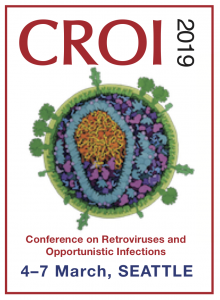Dolutegravir can be given with 3HP to prevent TB without dose adjustment
12 March 2019. Related: Conference reports, PK and drug interactions, TB coinfection, CROI 26 (Retrovirus) 2019.
 Polly Clayden, HIV i-Base
Polly Clayden, HIV i-Base
Dolutegravir (DTG) can be given with short-course TB preventive therapy of 12 once-weekly rifapentine/isoniazid (3HP) without dose adjustment, according to data from the DOLPHIN trial, presented at CROI 2019. [1]
Both DTG and 3HP are recommended by WHO. DTG is metabolised by CYP3A and UGT1A1 that are induced by rifamycins, including rifapentine. So giving them together could be tricky.
A previous study in HIV negative volunteers found a modest reduction in DTG trough concentrations. [2] But this was stopped early due to adverse events in two out of four participants.
DOLPHIN was a single arm phase 1/2 study of 3HP and DTG in HIV positive adults receiving ART, conducted to characterise safety, drug interactions, and viral suppression.
60 participants with undetectable viral load on efavirenz (EFV)-based regimens were recruited into 3 groups. All participants received DTG in place of EFV for 8 weeks, then started 3HP; after completing 3HP, all were followed for 4 more weeks.
Viral loads were measured at baseline and weeks 11 and 24. Groups 1A (n=12) and 1B (n=18) had intensive DTG pharmacokinetic (PK) sampling at week 8 (pre-HP), then weeks 11 and 16 following the 3rd and 8th doses of HP. Group 2 (n=30) received the same regimen and had sparse DTG PK sampling at weeks 8, 11 and 16.
Primary objectives were to: evaluate the effect of RPT and INH given at doses of 990 mg once weekly on the PK of DTG; and to assess the safety of DTG and 3HP co-administration.
The study took place in South Africa, it was conducted by the Aurum Institute and the Johns Hopkins University Center for TB Research as part of the IMPAACT4TB project. Enrollment was January to September 2018 and the last scheduled visit February 2019. Kelly Dolley presented the findings on behalf of the DOLPHIN trial team.
Of the 60 participants, 70% were women, median age was 40 years, all were black African, median CD4 was 683 cells/mm3, and median BMI was 28.9 kg/m2. All 60 completed the 12 HP doses.
There were three grade 3 adverse events (2 elevated creatinine, 1 hypertension).
DTG AUC was reduced by 29% at weeks 3 and 8. The geometric mean (GM) trough concentration of DTG in Group 1 (n=30) was: 0.85 (90% CI 0.42 to 1.20); 0.41 (90% CI 0.15 to 0.68); 0.39 (90% CI 0.18 to 0.87); and 0.47 (90% CI 0.29 to 0.88) on days 1, 2, 6 and 7 post-dose, respectively.
The investigators judged DTG levels to be sufficient, based on 96 week outcomes for 10 mg DTG in the original dose finding study SPRING-1. And viral load suppression <40 copies/mL was maintained throughout 3HP/DTG treatment.
References
- Dooley KE et al. Safety & PK of weekly rifapentine/isoniazid (3HP) in adults with HIV on dolutegravir. CROI 2019. Seattle. 4–7 March 2019. Oral abstract 80LB.
http://www.croiconference.org/sessions/safety-pk-weekly-rifapentineisoniazid-3hp-adults-hiv-dolutegravir (abstract)
http://www.croiwebcasts.org/console/player/41177 (webcast) - Brooks KM et al. Cytokine-mediated systemic adverse drug reactions in a drug-drug interaction study of dolutegravir with once-weekly isoniazid and rifapentine. Clin Inf Dis Feb 3 2018.
https://academic.oup.com/cid/advance-article-abstract/doi/10.1093/cid/ciy082/4836314

